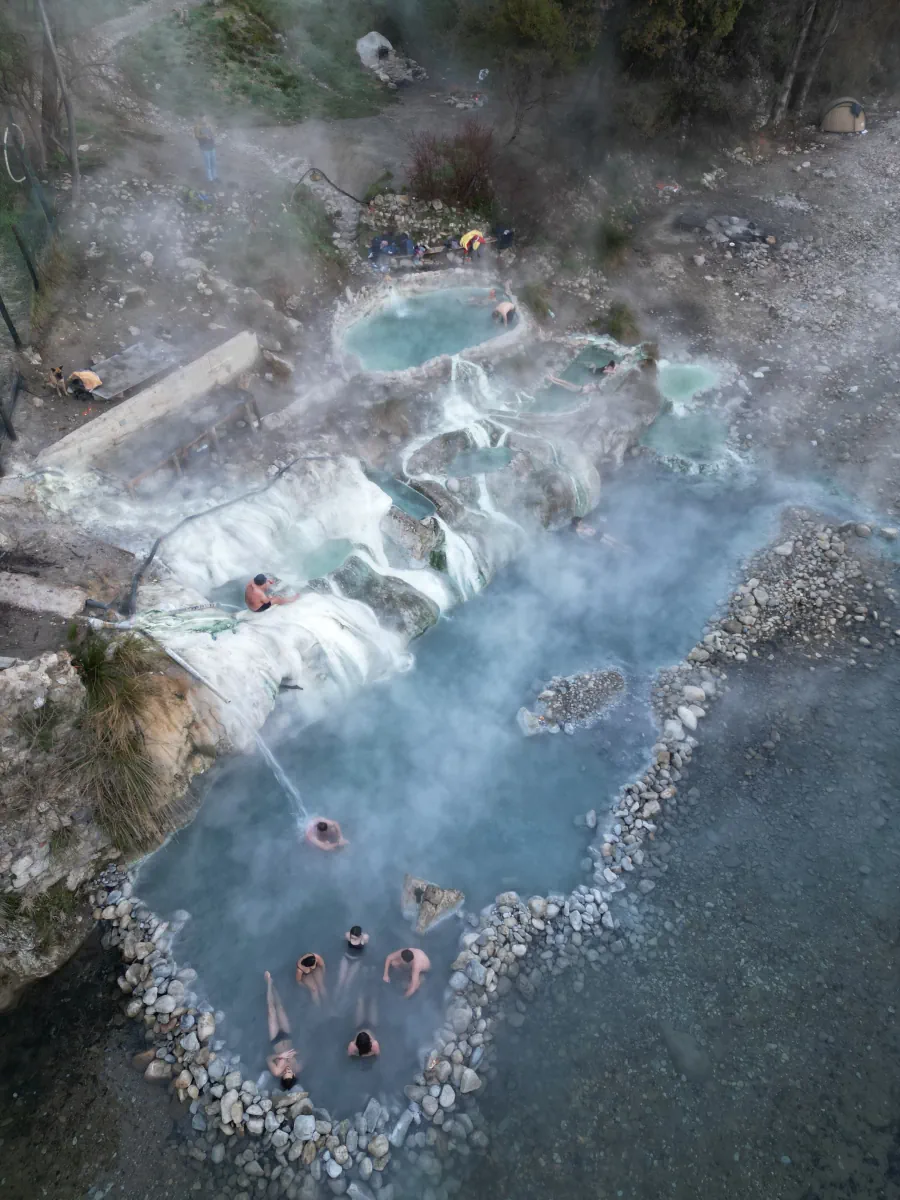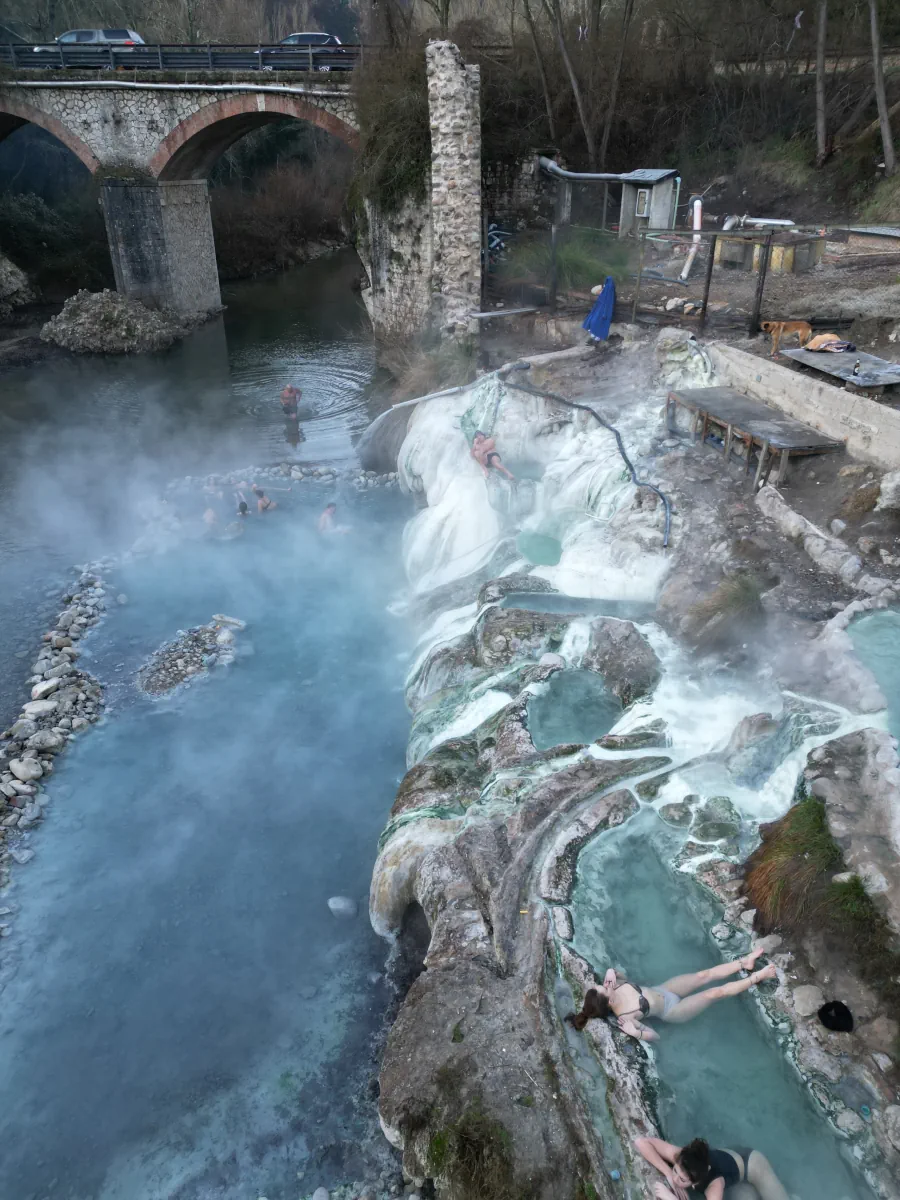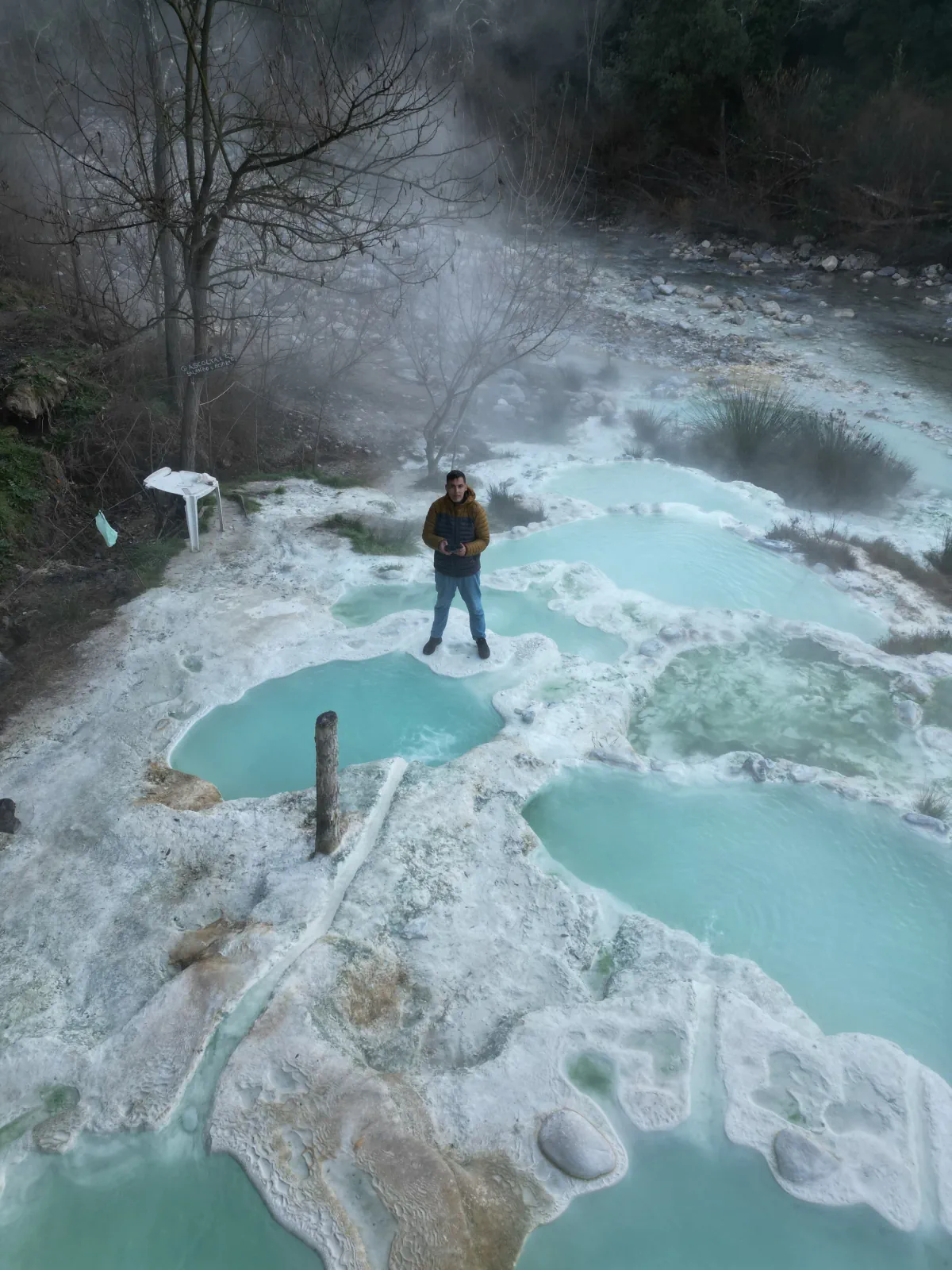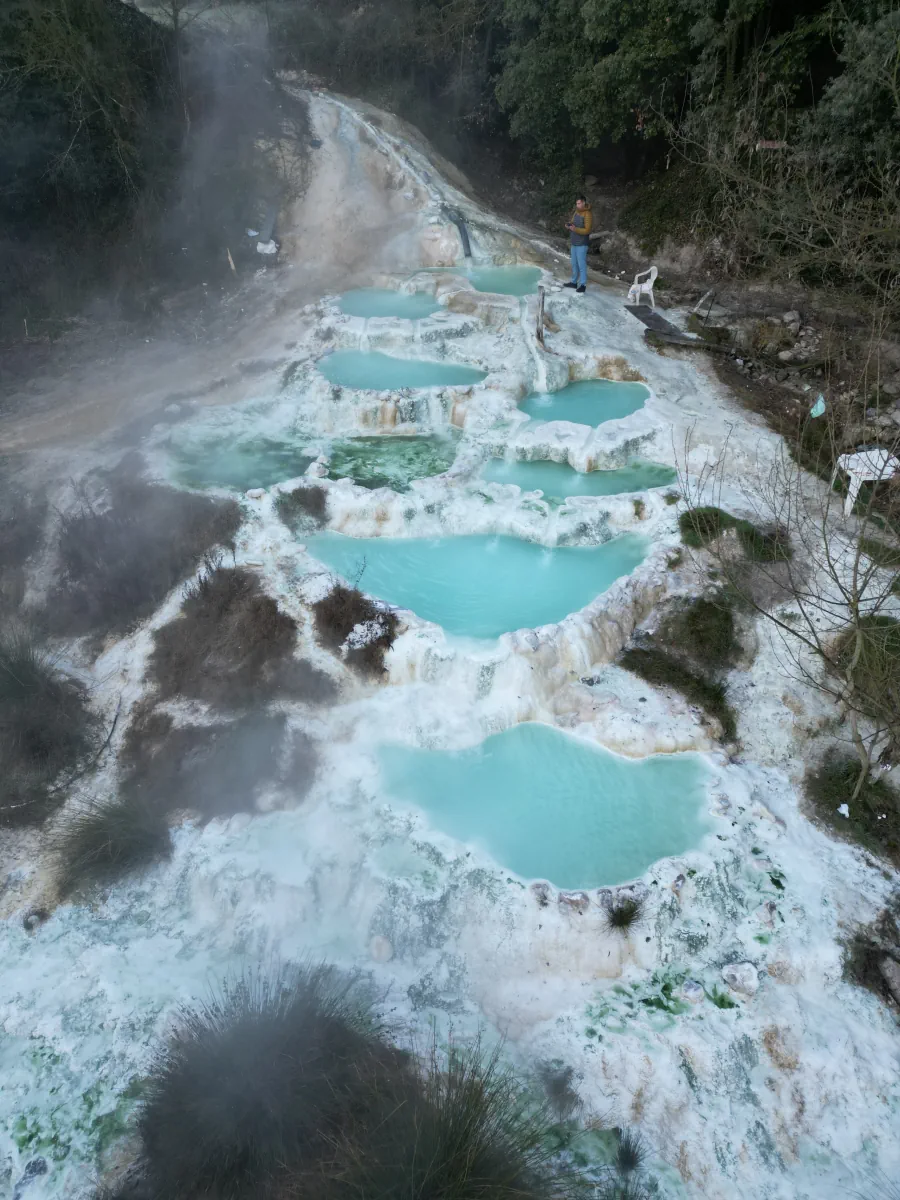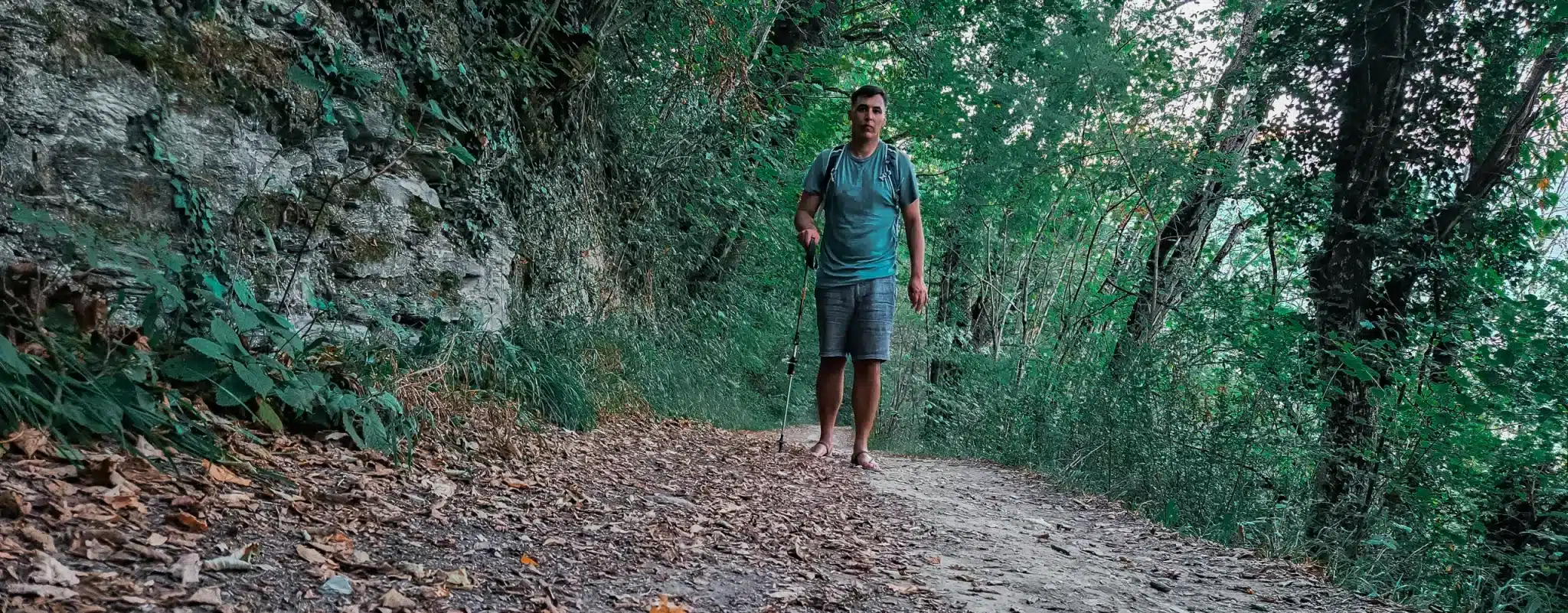Visit Terme di Petriolo – Hot springs in Tuscany
- Nature Source Chaude
- Published on
- Updated on 24 April 2025
Tuscany is one of the most beautiful regions in Italy and one of the most famous for its many hot springs. No fewer than forty hot springs sites were developed in the Middle Ages. The abundance of hot water in one place and the associated facilities allowed cities such as Siena to develop veritable spas such as Bagni di Petriolo.
In the past, the Baths of Petriolo were very famous and were considered one of the most beautiful treasures of Tuscany. But the place has lost some of its splendour. The thermal spring, on the other hand, has not changed and continues to flow uninterruptedly, bringing health to those who encounter it. So, I invite you to discover this place.
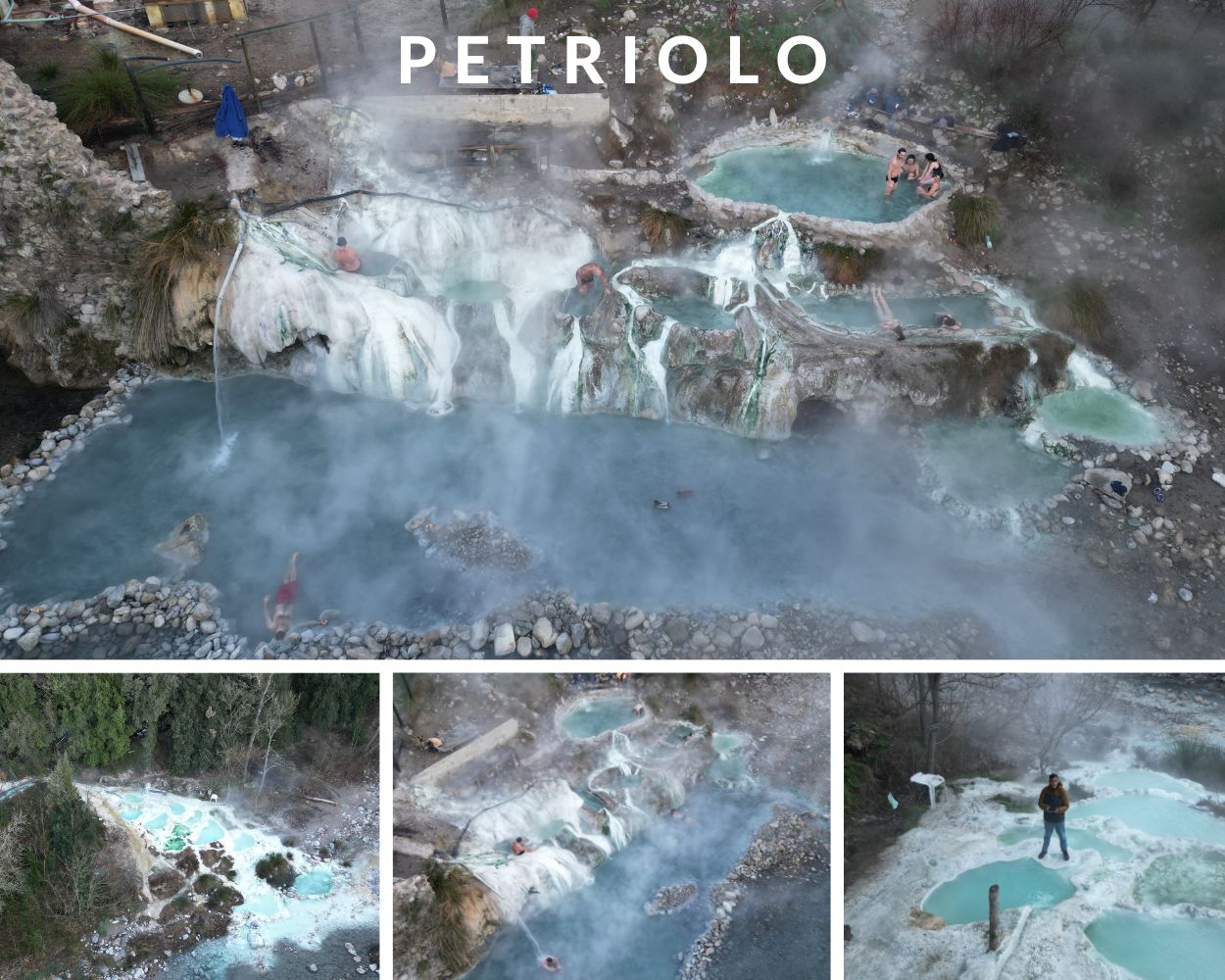
IN SUMMARY :
Petriolo thermal baths
If a place had hot springs, whether developed or not, many place names have been used throughout history to refer to them. The terms used could be ‘aqua’, ‘balneum’ or ‘bagno’ (plural ‘bagni’). Many of the spas still in use today use this word, such as Bagni di Petriolo.
In Bagni di Petriolo, the term ‘Terme di Petriolo’ is also used to refer to the thermal baths. There are also two bathing areas (the Terme libere di Petriolo) where you can bathe free of charge.
The thermal centre is located between the two natural sites. It has a large swimming pool, an outdoor terrace and a private car park. It offers a wide range of paid thermal treatments.
A little bit of the history
Discoveries have shown that these waters have been known and used since ancient times. Above all, the archaeological remains of the old spa, probably dating back to the 13th century, have been found.
On the banks of the river Farma, less than a hundred metres from the spring, there is an old bathhouse that was once very famous in the region. It consists of small pools open to the outside, with walls that are in danger of collapsing. This area, now closed to visitors, was probably visited by one of the most powerful families in Italy: the Medici.
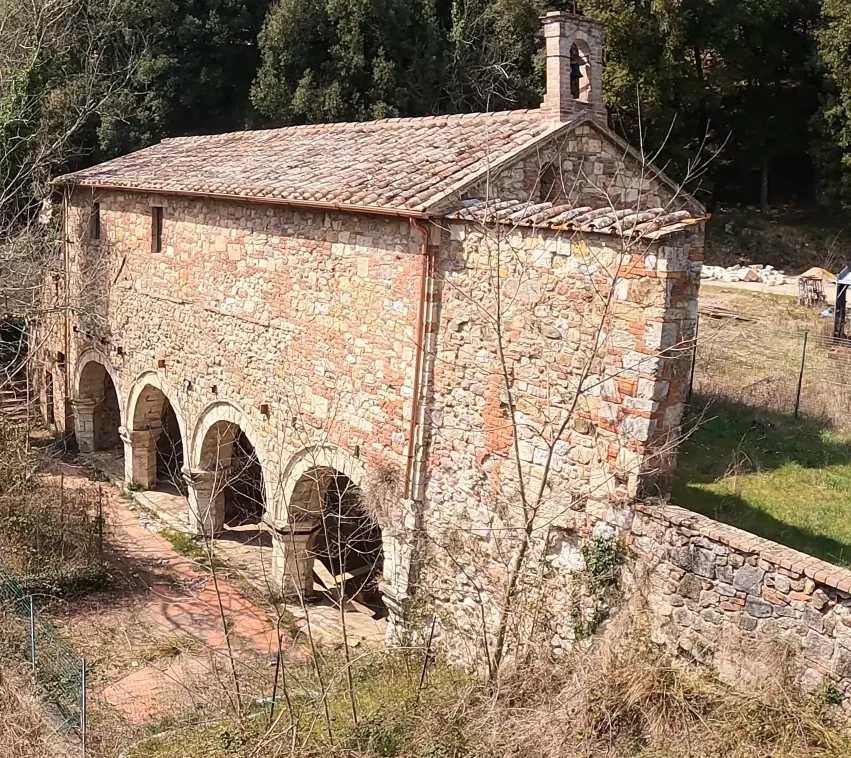
In fact, the 15th century saw a brutal privatisation of the spas by notables and great lords. Not content with being welcomed by foreigners, the Medici, the most powerful family in Tuscany, appropriated the collective baths of Bagno di Petriolo for their own use.
Bagni di Petriolo remained the most fashionable spa in Italy until the end of the 15th century, when it was surpassed in fame by two other Tuscan resorts : Bagni San Filippo and Bagno Vignoni. In the middle of the 16th century, the Terme di Petriolo were abandoned and began to fall into ruin.
Despite this lack of interest, probably due to a passing fad, these thermal baths collected thermal water that was known to be effective. It is still known today as the hottest and most sulphurous thermal spring (21 mg/l of H₂S) in Tuscany.
The natural thermal baths of Petriolo
Presentation of the site
To get to the free baths, just park on the side of the road. Then take a side path to the sulphur spring. From here you can see a long stretch of the shallow Farma River. You can even cross it on foot. The surrounding forests rise up in a nature reserve that is wonderfully soothing to the spirit.

A section of the wall in ruins protects the area around the spring from the rising waters of the river. These fortified walls, built in large numbers around the baths at the beginning of the 15th century, testify to the need of the old medieval town to protect itself from the brigands of the region. The area reserved for the spring is now surrounded by a simple fence.
I also noticed that some tourists would have preferred not to see the somewhat antiquated water collection system and pipes.
The use of old PVC pipes to supply the pools, which are visible, is not unanimously supported.
On the other hand, the water is neither pumped nor stored. It passes quickly (less than a second of contact with the PVC) through the pipes that lead it to the natural pools. In this way, the water quickly returns to the three elements it needs to thrive: soil, air and light.
Despite the limited land available around the spring, the local people have been able to create pools that are both designed and completely natural.
The hottest sulphurous spring in Tuscany
The limpid waters that animate one of the banks of the Farma River never stop flowing. They spread life and health to the brim in pools that are not lacking in elegance.
At the beginning of February, despite temperatures below 5°C, the first bathers arrived at dawn.
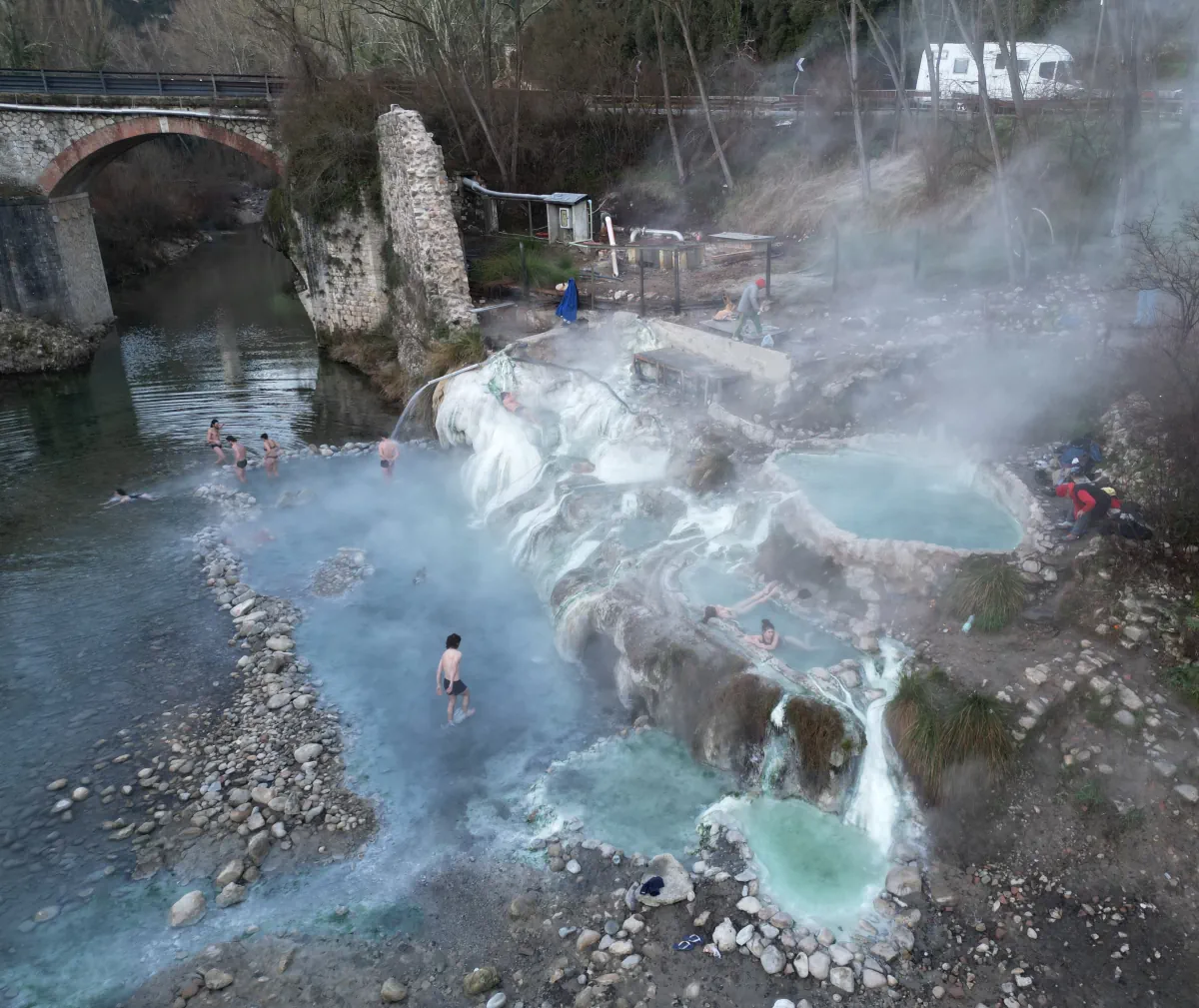
This beautiful thermal spring stands out for its volume and richness in active ingredients. What’s more, its rotten-egg smell is much stronger (21 mg/l of H₂S) than that of other springs in the region. To find out more about this gas (H₂S), I invite you to read the article “How to Cleanse your lungs with simple, natural ways”.
However, the temperature of the spring can be a little high, ranging from 42 to 45 degrees Celsius.
The abundance of naturally warm water near the pools means that they can be efficiently kept at a high temperature. I measured a temperature of 42.5°C in the large pool at the top. Although the pool is a little too warm, you can immerse yourself in the water or sit on the edge to get up to waist deep. If you are feeling brave, you can dive up to your neck.
Some of the pools on the lower level are smaller and cooler so you can soak for longer. As for the stone pool in the riverbed, the water is still very warm and pleasant. If you’re short of space, the river is right next door.
The hot baths and showers of Petriolo
The therapeutic shower, an ancient practice
In addition to bathing and drinking, a new practice appeared in Italy in the 14th century, mainly in some Tuscan towns (San Filippo, San Casciano…).
This was the therapeutic shower, encouraged by doctors and introduced for the first time in 1403 at Bagni di Petriolo. According to some doctors, water falling directly on the head was a relatively effective treatment for diseases of the head and drove the ‘humours’ out of the brain. This led to the construction of a number of elevated facilities.
This practice also led to the creation of a new tax called ‘la gabella de docci del lavare el capo’ [reference], which literally means ‘ the shower tax for washing the head’. In fact, this practice had already existed since ancient times and was mentioned by several authors.
Nowadays it is used in thermal centres as a ‘filiform shower’. Used exclusively by a doctor, the filiform shower emits fine jets of water under variable pressure. This technique is said to be particularly effective in the treatment of acne, eczema, skin lesions, mechanical remodelling of the skin and even burns.
A shower with natural hot water?
To get a natural hot water shower, you also need the right terrain. The configuration of the site must allow the formation of a cascade. In this way, by allowing the thermal water to flow in a natural and uncovered way, there is no need to worry about the denaturing of the water.
The layout of the site in stepped pools allows the formation of small natural showers. Along the flow channels you can clearly see a sediment marked by white matter. It is through these white travertine flow channels that we should look for the formation of small cascades.
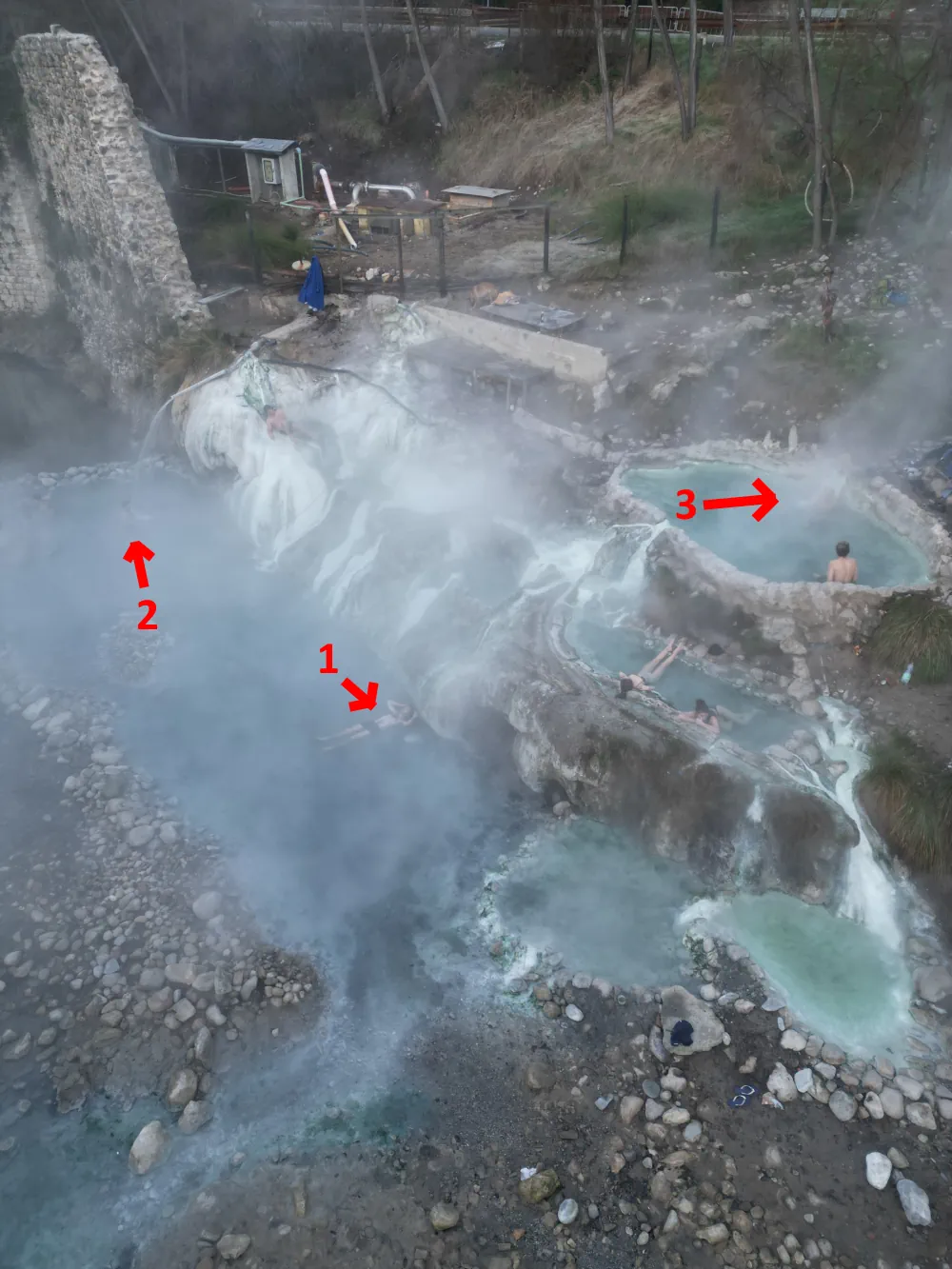
In the picture, a bather (1) is lying on his back, enjoying a real treatment. At the same time he is listening to the sound of the cascades.
The abundance of hot water also means that a high flow rate can be maintained in all the pipes coming out of the spring catchment. The pipe (2) that supplies water to the large pool built on the riverbed never stops flowing. This high flow rate and the two metre head naturally allow the water to increase its kinetic energy, giving bathers a powerful therapeutic shower.
As for the upper pool, it is fed directly from a pipe buried underground. The resource (flow) is so great that it is not necessary for the water to fall from a certain height. One bather (3) seems to have found happiness by sitting just below.
It is not just a single mass of water falling on his head. It’s made up of layers that slide over each other and whose surfaces are extremely sensitive to external stimuli (light, noise, pressure, electromagnetic waves, etc.). This is why we go to the bath to relax, meditate, heal ourselves and take the opportunity to disconnect from the digital world, which seems to be a real challenge these days.
Other natural pools next to the forest
A few hundred steps from the natural thermal baths, just after the paid ones, Bagni di Petriolo provide another pleasant place for those in search of a hot bath.
All you have to do is cross the woods along a well-worn path. In just a few minutes you can reach other natural pools on the bank of the Farma river. Another great free place in Petriolo to rejuvenate yourself physically and mentally.
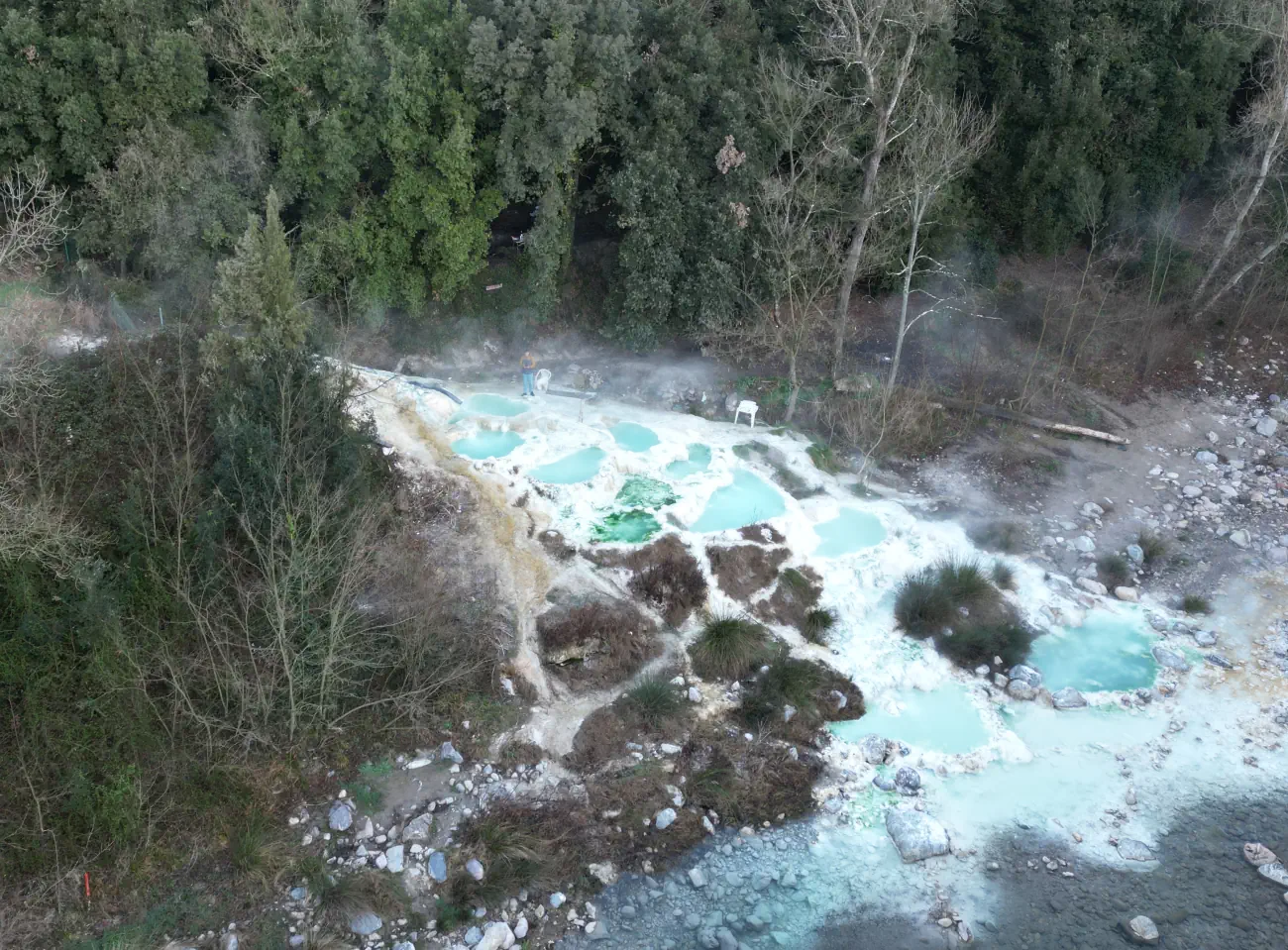
The water in this spring comes from the thermal centre. This centre is fed by a particularly generous thermal spring (the same source as the previous natural site, with a total flow of 40 l/s.). This water flows continuously into a large concrete pool on the terrace of the thermal centre. The water is not chemically treated.
The water is then drained through a natural channel outside the centre. The water then flows into a large black pipe just above the first pool. The temperature in this pool is around 36 to 37 degrees. If the water on the other side is too hot, there’s always an alternative here.
Last but not least, the travertine terraces that characterise the beauty of the site are not inert. The soil is rich in the micro-organisms that are essential for these waters. To find out more, I invite you to read the article “The soil, base layer and living medium of a hot spring”.
Informations
How do I get to Petriolo?
The best way to reach Bagni di Petriolo from Siena is by car. However, the more adventurous can take the Siena-Grosseto bus, which will drop them off a few kilometres from the site. The bus leaves from Piazza Gramsci in Siena.
A few useful tips
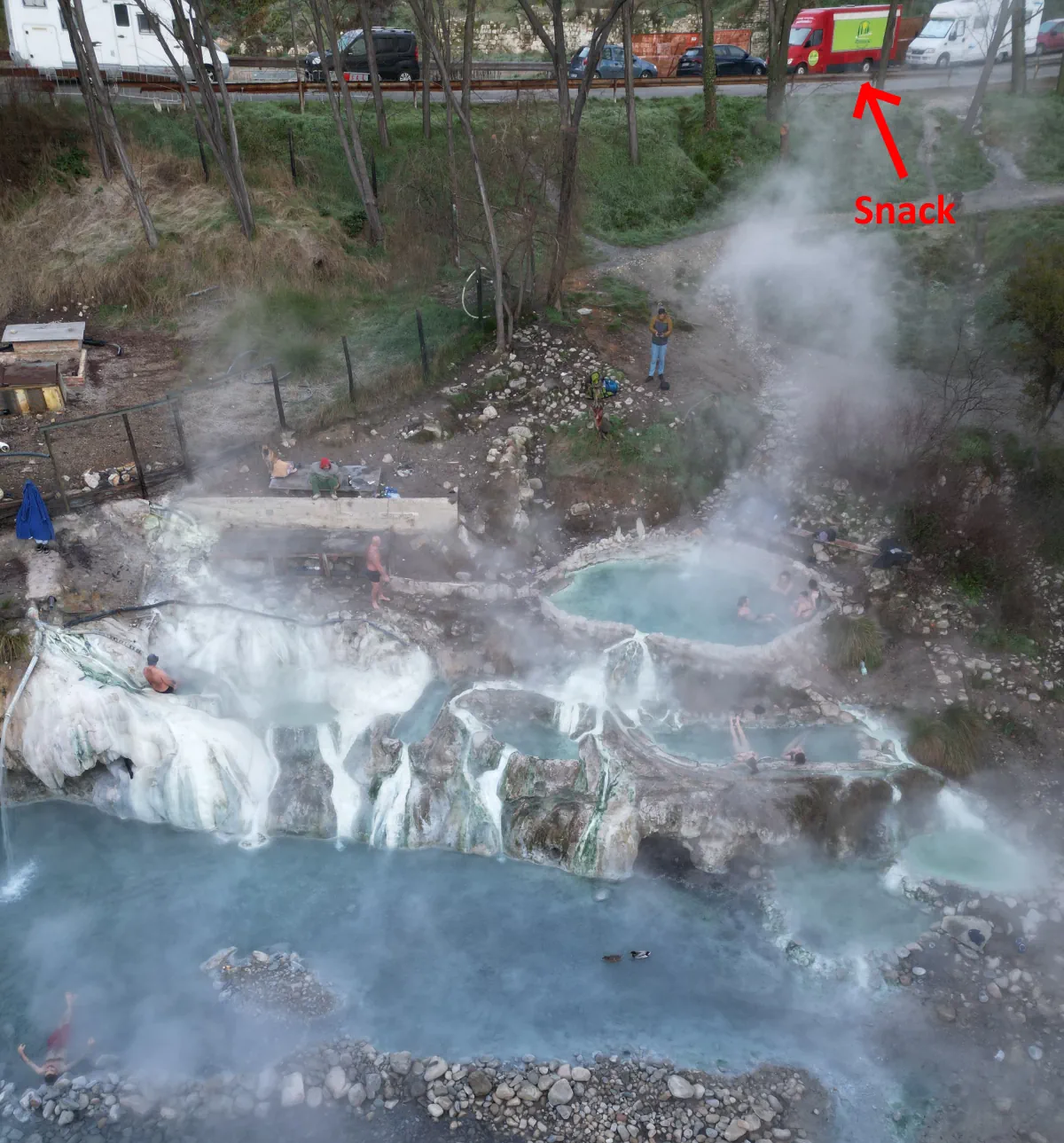
The site was relatively well maintained when I visited, but this was not always the case. Respect the site and take your rubbish with you, as there are no bins on site (apart from the one in the snack bar).
Water sandals can always be useful for accessing the spring, but are not compulsory. It is advisable to remove jewellery, bracelets and silver earrings before bathing, as the spring is very sulphurous.
A thermal bath makes your body work hard and makes you hungry. Don’t forget to bring something to eat. Otherwise, there’s a snack bar just above the spring.
The best months to visit Petriolo are September to February, because of the water temperature. However, as there is another site (next to the forest) where the water is cooler, there is no recommendation on this point. You can also find the location of the thermal baths on our map of Italy’s hot springs.
Petriolo water: its nature and benefits
The waters of Bagni di Petriolo are considered hyperthermal sulphurous waters at 43°C. It is rich in minerals (calcium, magnesium, etc.). It is recommended for the treatment of rheumatic, dermatological and respiratory diseases.
The waters are not only active externally. They can also be beneficial when taken internally (in the form of a drink).
Reference
26 Janvier 1403, Archivio di Stato di Siena, Consiglio Generale 200, fol. 155-155v


